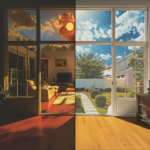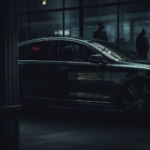To the untrained eye, window tint appears to be nothing more than a dyed sheet of plastic. Yet at around $100 a yard, modern tinting films are anything but. In fact, they are transparent pieces rife with modern nanotechnology – a big step up from it’s useful yet uncomplicated historic models.
Historically – Window Tint in The Past
Before we jump into how modern window tint works, let’s look at where it has come from. It is always important to know where something came from to properly appreciate where it is at.
The very first window tint could be seen in the time following World War II. A few luxury vehicles at the time had factory tinting, but most did not. When people without factory tint wanted their vehicles to have it, they had to use spray tinting. This left a very dark, incredibly uneven finish that didn’t appeal to a person’s aesthetics, and often did not even do an appropriate job.
With this plight in mind, window tinting film was finally invented in 1966. It was a dye-based film which, although much better than the spray previously used, was not yet perfected. It tended to absorb heat instead of deflecting it, and it also tended to turn purple and bubble up. Not very pretty, yet this is where the idea for modern films (those we use today) are born.
Enter Invisible Tinting
The market was once dominated by darkness. The more privacy and light deflection you wanted, the darker the tinting had to be. While this has always presented a very cool aesthetic, there have also always been legal issues with these models. Nearly all states have laws against how dark a person’s vehicle windows can be.
Recently, however, the game has completely changed because tint darkness and effectiveness have been turned into separate entities. You may still choose to have dark tinting but can have the effects of such with a much lighter coloring if desired.
Does “Invisible Tinting” Actually Work?
Invisible tinting works just as well as traditional dark-colored models. They block nearly all infrared and ultraviolet (UV) lighting. UV lighting is the one responsible for discoloration of interiors, and sunburns. The highest quality transparent films have been measured to an equivalent of SPF 1,000 sunscreen.
Things to Consider When Looking to Purchase
With this innovative technology, purchasing offers a wide range of options. Yet it is not only coloring and effectiveness which need to be thought about. Getting tint off your vehicle once it’s been placed on is a very messy, time-consuming business so you want to ensure it’s the perfect one for you – and that you will be satisfied with it for years to come.
Do the following prior to purchase:
- Add your car’s factory tinting level to the level of your desired film. Compare this against your state’s tinting laws to ensure it is within the legal limits.
- Do your research on various brands and choose the one which has the highest quality of light protection. Different films will protect against varying levels of ultraviolet, infrared, and visible light.
- Research whether the film is signal-friendly, as some tend to disrupt wireless signals thanks to metals used in their processing.







Comments are closed.